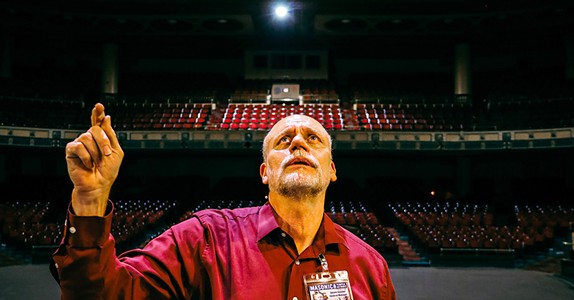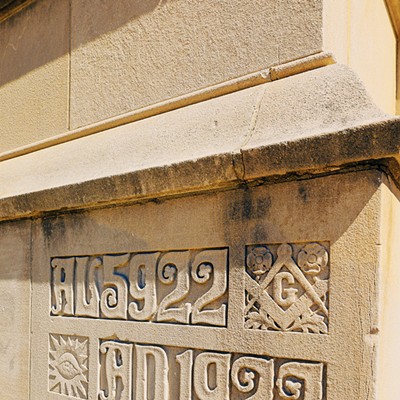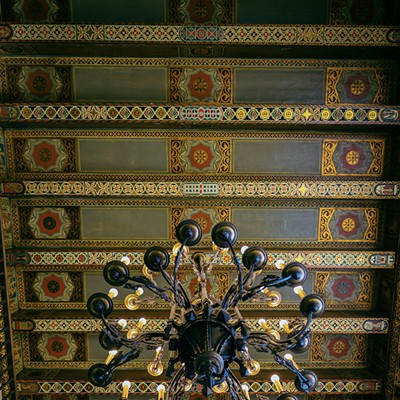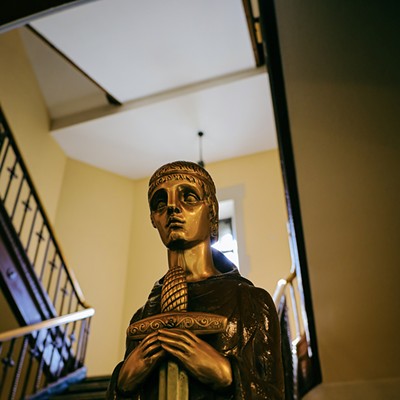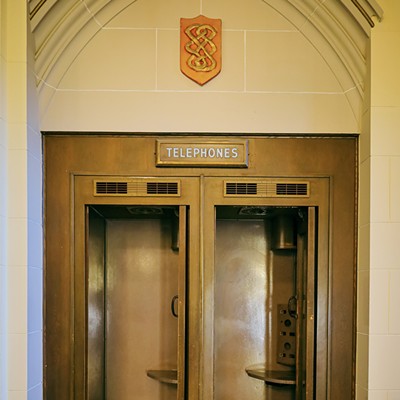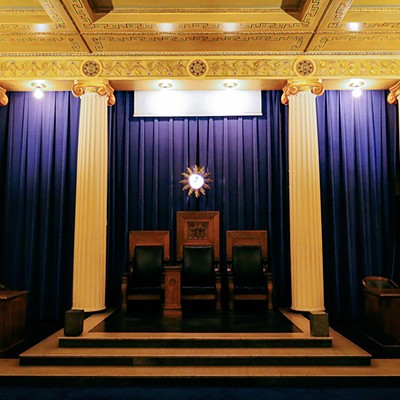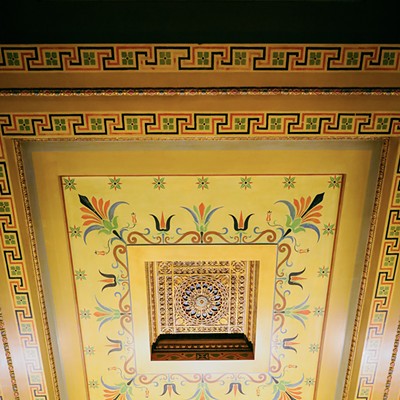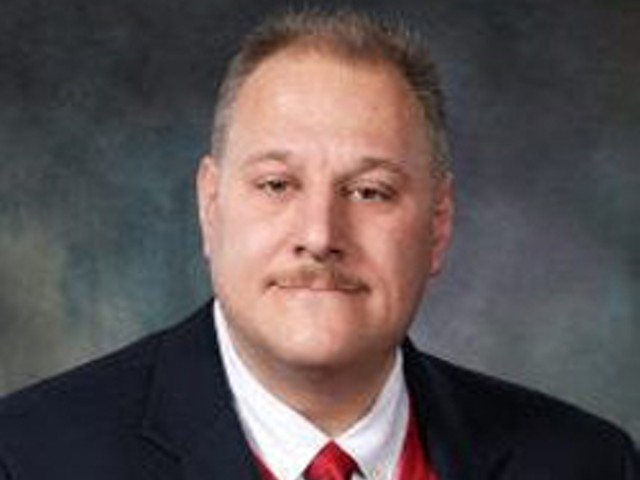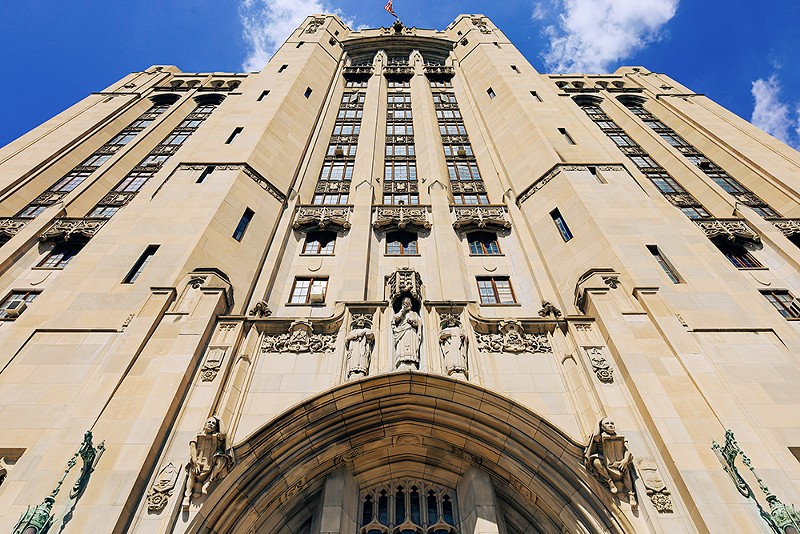
Detroit’s Masonic Temple is where worlds meet. It’s a place where Jack White can get married in front of a crowd of nearly 5,000 during an impromptu wedding concert; where Halloween revelers gather for Theatre Bizarre, “The Greatest Masquerade on Earth”; where Detroit Roller Derby matches are held — and a whole bunch of other esoteric stuff goes on in the name of the Freemasons, a mysterious fraternal order that we admit we still don’t quite understand.
With its painted ceilings, crystal chandeliers, and stained glass chapels, the 210-foot tall, 14-story building is the largest Masonic Temple in the world, boasting 16 floors and 1,037 rooms, some of which were never completed. In more recent years, weddings, film productions, and wrestling matches have been hosted within its limestone walls. And in 2019, live music company AEG Presents entered into an exclusive deal to operate and book at the building’s two concert venues, the 4,400-capacity Masonic Temple Theatre and the 1,586-capacity Cathedral Theatre.
But how did this mystifying building land on the corner of Temple Street and Second Avenue in Detroit’s Cass Corridor? If anyone is equipped to answer that question, it’s Masonic Temple general manager Steve Genther, who’s worked there for 40 years.
Genther, a Freemason himself, takes us on a tour of the Masonic’s ritual initiation chambers, theaters, and an eerie unfinished pool. Opened in 1926, the Masonic Temple was designed by architect George Mason, and took six years and $6.5 million (about $87.9 million in today’s dollars) to build and furnish, Genther tells us. Mason broke ground on the building in 1920, but the first cornerstone was laid in 1922 using George Washington’s trowel, which was also used to lay the first bricks at the U.S. Capitol.
On Saturday, Sept. 24, the Masonic Temple will host a centennial celebration of the cornerstone with a rededication ceremony and red-carpet gala in its newly restored Fountain Ballroom. Washington’s trowel will be also displayed at the 100-year anniversary celebration.
The Masons are a spiritual fraternity with lodges across the world dating back to the 13th century. But even after hours exploring the Masonic Temple, with Genther as our encyclopedic tour guide, we’re still not exactly sure what Masons do, other than donating to charity and holding elaborate, secretive meetings.
While the Freemasons were once adept stone builders, Genther says these days anyone without a criminal record who “believes in a Supreme Being” can join — as long as they’re male. Yes, women are still prohibited from being Freemasons (if only you could see our eyes roll), but can join other adjacent groups like the Order of the Eastern Star or Daughters of the Nile, which are for women only.
“A Freemason is somebody that takes the working tools that a stonemason would use to build an actual temple and symbolically they take those working tools to build a temple within themselves,” Genther says. “So the premise is to take good men and make them better.”
At its peak, around 50,000 Masons met at the Masonic Temple, but these days it’s more likely to be used as a concert hall or movie set. Ryan Gosling shot his 2014 film Lost River here, and the 2016 asylum thriller Eloise was filmed in the Temple’s unfinished (and creepy) theater. Musicians including Eminem, Nicki Minaj, and Big Sean have used the Masonic as a backdrop for their music videos. Aretha Franklin even shot an American Express commercial there.
“One time we had three different movies filming in our building, and I learned that you never do that,” Genther remembers. “If you’ve got three movies that want to film in your building at the same time, don’t do it. One at a time.”
Mason symbolism is all around the building, including the numbers three, five, and seven. For example, all the lodge rooms include stairways with three, five, and then seven steps between landings.
“It has to do with, you know, the universe and things like that. I don’t know for sure,” Genther says when we ask why these numbers are favored by Masons. “The numbers also mean other things like the three degrees for the first few steps, the five senses, and then seven liberal arts and sciences.”
Beyond the mystery of the Masons, the buildings also have a reputation for being haunted. When we arrive at the Masonic, a security guard boasts about paranormal investigators who flock to the building in search of ghostly activity. Some visitors have allegedly reported experiencing cold spots, doors closing suddenly, feeling like they are being watched, and other unexplained phenomena.
Genther says the haunted claims stem from stories that architect George Mason jumped off the Masonic’s roof because he was distraught that he couldn’t complete the building. But as Genther notes, Mason actually died peacefully in his home.
“That’s kind of an urban legend,” he says. “We’ve always had these groups that want to come through. I get calls all the time saying, ‘Oh, we heard you’re haunted. We want to do a thing.’ Obviously, we’re a for-profit company, so if you want to rent space to do that, sure, you can. Some people have told me that they felt a presence or ghost or whatever. But I’ve personally never seen it myself.”
We didn’t experience anything ghostly during our time riding the building’s 1920s crank elevator and traversing its mezzanines and grand ballrooms, either.
Erin Miracle, the Masonic’s social media manager, has her own theory of why people may “feel a presence” in the temple.
“I’ve only been part of the Masonic Temple since February, but every time I come in every day, it’s magical,” she says. “Everything this building was made of holds energy. And there has been so much energy in this building. Music carries energy, people carry energy. I feel like just with what the building is made out of and the energy that has been within these walls, it’s impossible not to feel something.”
That energy was nearly lost when the Masonic Temple almost went into foreclosure in 2013, until Jack White paid $142,000 in back taxes owed by the building. White’s mother worked as an usher at the building and reportedly had a love for its neo-gothic architecture. The Masonic Temple houses a signed poster from White from his 2014 gig there, which shows a woman standing in front of the building, protecting it from an impending storm.
Miracle is right: It’s impossible not to feel something within the building’s storied walls. Whether it’s admiration for its intricate architecture or curiosity (or confusion) about the Freemasons, there’s no denying Detroit’s Masonic Temple is a strange and magical place.
Stay connected with Detroit Metro Times. Subscribe to our newsletters, and follow us on Google News, Apple News, Twitter, Facebook, Instagram, Reddit, or TikTok.

